Last Updated on 5 months by Francis
Infrared rays, also known as IR, exist within the electromagnetic spectrum between visible light and microwave radiation. While they may be invisible to the human eye, they can be detected and measured using specialized instruments and sensors. Infrared radiation is emitted by all objects with a temperature above absolute zero, and it has a multitude of practical applications in various industries.
Contents
Key Takeaways:
- Infrared rays cannot be seen by the human eye.
- Specialized instruments and sensors can detect and measure infrared radiation.
- Infrared technology has practical applications in multiple industries.
- It is emitted by objects with a temperature above absolute zero.
- Infrared technology plays a vital role in fields like night vision, remote sensing, and medical diagnostics.
Understanding Infrared Technology

Infrared technology is a fascinating field that harnesses the power of the electromagnetic spectrum beyond what the human eye can perceive. It relies on the principle that objects emit different amounts of infrared radiation based on their temperature, allowing for the detection and measurement of this invisible energy. By capturing and converting infrared radiation into visible images or data, specialized instruments and sensors enable us to explore a whole new world.
One of the key advantages of infrared technology is its ability to bridge the gap between what is visible and what lies beyond. The electromagnetic spectrum encompasses a wide range of energies, with visible light occupying only a small portion. Infrared radiation falls just beyond the red end of the visible light spectrum, making it imperceptible to our eyes. However, it plays a crucial role in many fields, from night vision to medical diagnostics and electrical maintenance.
In the realm of electrical maintenance, infrared technology has become indispensable. By using thermographic cameras and sensors, professionals can detect temperature anomalies in electrical components, which may indicate potential issues. Loose connections, overloading, and other electrical problems can be identified early on, allowing for timely interventions to prevent equipment failure or electrical fires. This proactive approach ensures the safety and efficiency of electrical systems.
Applications of Infrared Technology
Infrared technology finds applications in various industries and everyday life. Let’s take a closer look at some of the key areas:
- Night Vision: Infrared technology is widely used in night vision goggles and cameras, enabling military personnel and law enforcement agencies to operate effectively in low-light environments.
- Remote Controls: Many electronic devices, such as televisions and air conditioners, rely on infrared remote controls for seamless operation.
- Medical Applications: Infrared thermometers and imaging are used for non-contact temperature measurements and medical diagnostics, respectively, providing valuable insights for healthcare professionals.
- Home Insulation: Infrared technology is utilized to assess the effectiveness of home insulation by identifying areas of heat loss or infiltration.
- Industrial Inspections: Infrared imaging allows for efficient and non-invasive inspection of industrial equipment, helping identify potential faults or inefficiencies.
With its wide range of applications and continuous advancements, infrared technology continues to shape various aspects of our lives. From enhancing safety and efficiency to revealing hidden insights, it opens up new possibilities for exploration and innovation.
Table: Comparing Infrared and Visible Light
| Aspect | Infrared Radiation | Visible Light |
|---|---|---|
| Perception | Not visible to the human eye | Visible to the human eye |
| Source | Emission from objects with a temperature above absolute zero | Sunlight, artificial light sources |
| Wavelength | Longer wavelengths (700 nm to 1 mm) | Shorter wavelengths (400 nm to 700 nm) |
| Applications | Night vision, remote sensing, medical diagnostics, electrical maintenance, and more | Visual perception, photography, communication |
As the table above illustrates, infrared radiation and visible light differ in various aspects, including perception, source, and applications. While visible light allows us to see the world around us, infrared radiation expands our understanding and enables us to tap into the unseen realm of thermal energy.
“Infrared technology bridges the gap between what is visible and what lies beyond, allowing us to explore a whole new world of thermal energy.” – Anonymous
Applications of Infrared Technology

Infrared technology has become an integral part of our everyday lives, with a wide range of applications in various industries. Let’s explore some of the key areas where infrared plays a crucial role.
Night Vision
One of the most well-known applications of infrared technology is in night vision devices. These devices use infrared sensors to detect and capture the heat emitted by objects, allowing users to see in complete darkness. Night vision technology is vital for military operations, law enforcement, and surveillance purposes.
Remote Controls
Infrared technology is the backbone of remote control systems that we use to operate our TVs, air conditioners, and other electronic devices. When you press a button on your remote control, it emits a beam of infrared light that is picked up by a sensor on the device, triggering the desired action.
Infrared Saunas
Infrared saunas use infrared light to produce heat, providing various health benefits. Unlike traditional saunas that heat the air around you, infrared saunas directly heat your body, causing you to sweat and release toxins. The infrared heat also helps relax muscles, improve blood circulation, and promote overall well-being.
Medical Applications
Infrared technology has found numerous applications in the field of medicine. Infrared thermography is used for non-invasive temperature measurements, allowing for early detection of inflammation, infection, or circulation issues. Infrared imaging is also used for breast cancer screening, as tumors emit heat differently than healthy tissues.
Home Insulation
Infrared technology is utilized in assessing home insulation to identify areas of heat loss. Infrared cameras can detect temperature differences on the surface of a building, indicating insulation gaps or air leaks. This information helps homeowners and professionals improve energy efficiency and reduce heating and cooling costs.
Industrial Inspections
Infrared technology is extensively used in industrial inspections, particularly in electrical maintenance. Thermographic cameras can detect anomalies in electrical systems, such as overheating components, loose connections, or overloaded circuits. Regular inspections using infrared technology help prevent equipment failures, electrical fires, and ensure the safety and reliability of industrial operations.
As you can see, the applications of infrared technology are vast and diverse, spanning from night vision and remote controls to medical diagnostics and industrial inspections. The ability to harness and utilize infrared radiation has revolutionized various industries and improved our quality of life. Whether it’s enhancing safety, optimizing energy efficiency, or advancing medical diagnostics, infrared technology continues to play a vital role in shaping our modern world.
Infrared in Electrical Maintenance
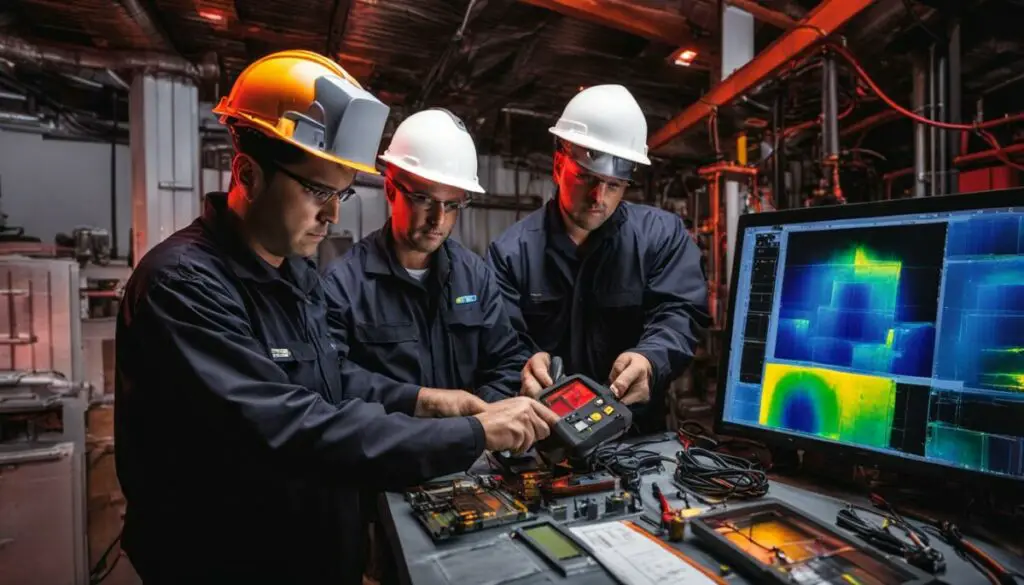
When it comes to ensuring the safety and efficiency of electrical systems, infrared thermographic inspections have become an indispensable tool. By harnessing the power of infrared technology, these inspections can detect temperature anomalies in electrical components, allowing for the early identification of potential issues.
Infrared cameras, equipped with advanced sensors, can capture the infrared radiation emitted by electrical components. This radiation is then converted into a visible image or data, revealing temperature variations that may indicate loose connections, overloaded circuits, or other electrical problems. By detecting these issues early on, preventive measures can be taken to avoid equipment failure, electrical fires, and costly downtime.
Electrical system safety is of paramount importance, especially in industries where even minor disruptions can have catastrophic consequences. Infrared thermographic inspections provide a non-contact, non-destructive method for evaluating the condition of electrical systems. By identifying hotspots and potential problems before they escalate, facility managers and maintenance teams can proactively address issues, prioritize repairs, and ensure the overall reliability and safety of the electrical infrastructure.
| Benefits of Infrared Thermographic Inspections | Applications |
|---|---|
| Early detection of electrical issues | Industrial facilities |
| Preventive maintenance | Commercial buildings |
| Reduced risk of equipment failure | Hospitals and healthcare facilities |
| Improved electrical system safety | Power generation stations |
| Minimized downtime and repairs | Data centers |
Maximizing Electrical System Performance
In addition to identifying potential issues, infrared thermographic inspections can also provide valuable insights for optimizing electrical system performance. By analyzing the captured data, maintenance teams can identify areas of inefficiency, such as overloaded circuits or voltage drops, and take appropriate actions to improve system reliability.
Regular infrared inspections can be incorporated into a comprehensive preventive maintenance program, helping to establish a proactive approach to electrical system management. By implementing a systematic inspection schedule, potential problems can be identified and addressed in a timely manner, minimizing the risk of unexpected failures and costly repairs.
Regular infrared inspections can save businesses both time and money by preventing costly equipment failures and electrical fires. By identifying potential issues early on, maintenance teams can proactively address them, ensuring the safety and reliability of electrical systems.
Overall, infrared thermographic inspections offer a valuable tool for electrical maintenance professionals. By harnessing the power of infrared technology, these inspections provide a non-invasive, efficient, and accurate method for assessing the condition of electrical systems. With their ability to detect temperature anomalies and potential issues, infrared inspections play a crucial role in ensuring the safety, efficiency, and reliability of electrical infrastructure in various industries.
The Role of Infrared in Astronomy
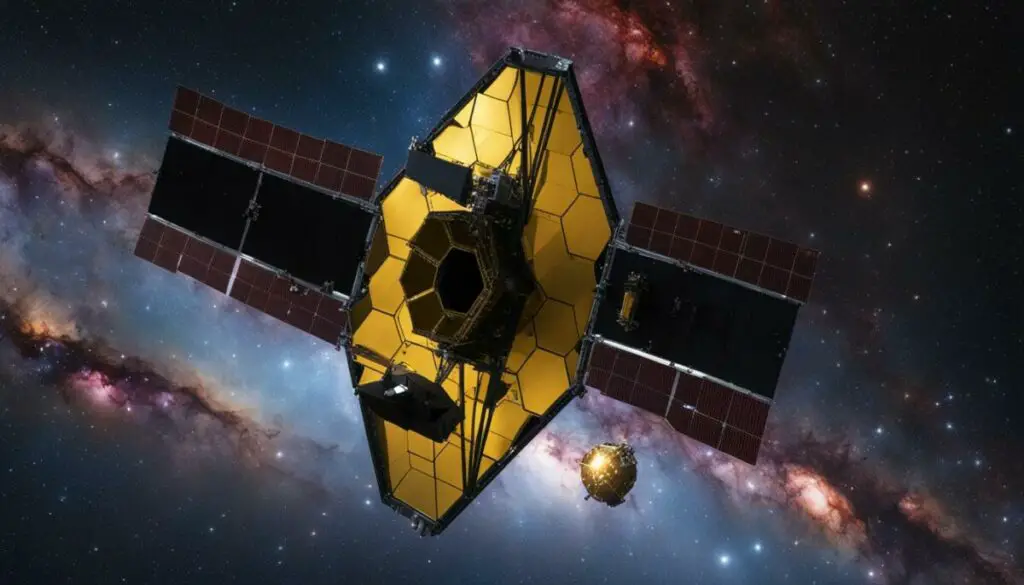
The James Webb Space Telescope (JWST), equipped with the ability to detect infrared light, has revolutionized our understanding of the universe. Infrared light, which falls outside the range of human vision, opens new windows of observation and reveals features that are not visible in other wavelengths. This unique capability has significantly advanced our knowledge in various areas of astronomy.
One of the key contributions of the JWST is its ability to study star formation. Infrared observations provide a clear view of regions where new stars are born, allowing astronomers to investigate the early stages of stellar evolution. By observing objects that emit low-energy infrared light, such as brown dwarfs and young protostars, scientists gain valuable insights into the mechanisms behind star formation.
In addition to star formation, the JWST enables astronomers to explore the mysteries of the early universe. By studying distant galaxies, the telescope detects redshifted infrared light that has traveled billions of light-years to reach us. This information provides valuable clues about the early stages and evolution of galaxies, as well as the presence of dark matter.
“The James Webb Space Telescope opens a new era in infrared astronomy, allowing us to see the universe in a completely different light. It provides us with the tools to study star formation, investigate the early universe, and delve into the hidden aspects of celestial objects. The discoveries made by the JWST will undoubtedly reshape our understanding of the cosmos.” – Dr. Emily Smith, Astronomer at the Space Observatory Institute
The James Webb Space Telescope has truly expanded our knowledge of the universe by leveraging the power of infrared light. Its observations have shed light on the intricate processes of star formation, unveiled hidden features of celestial objects, and provided insights into the early universe. As the telescope continues to explore the cosmos, we can anticipate even more groundbreaking discoveries that will shape our understanding of the vast expanse beyond our planet.
| Key Discoveries | Implications |
|---|---|
| Observation of star formation | Enhances our understanding of the birth and evolution of stars |
| Detection of redshifted light | Provides insights into the early universe, dark matter, and galaxy evolution |
| Exploration of celestial objects | Reveals hidden features and unveils new mysteries in the cosmos |
| Advances in infrared astronomy | Leads to significant advancements in our overall understanding of the universe |
Infrared Detection of the Milky Way’s Center
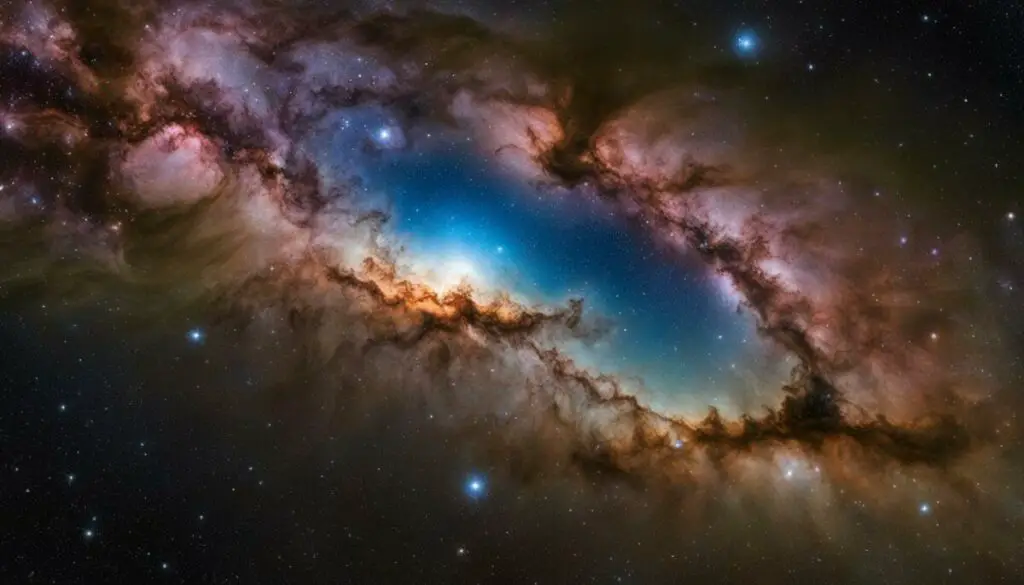
Using the James Webb Space Telescope, astronomers have made a groundbreaking discovery in the center of the Milky Way galaxy. They have observed an active region known as Sagittarius C, where intense star formation takes place. This observation has provided invaluable insights into the formation of stars in extreme environments and the prevalence of massive stars.
The image captured by the James Webb Space Telescope shows a cluster of protostars, young stars in the early stages of formation, surrounded by ionized hydrogen emissions. This indicates the presence of intense stellar activity and ongoing star formation processes within Sagittarius C. These findings shed light on the complex mechanisms involved in the birth of stars and the evolution of galaxies.
| Observation | Details |
|---|---|
| Location | Sagittarius C, the center of the Milky Way galaxy |
| Key Features | Cluster of protostars surrounded by ionized hydrogen emissions |
| Implications | Insights into star formation processes and prevalence of massive stars |
This discovery holds significant implications for our understanding of stellar evolution and the structure of galaxies. The presence of massive stars in Sagittarius C suggests a unique environment that contributes to the overall dynamics and evolution of the Milky Way. Further study of this active region will unveil additional secrets about the intricate processes that shape our galaxy.
Star Formation in Extreme Environments
Studying star formation in extreme environments like Sagittarius C allows astronomers to explore the limits of the known star formation theories. The intense radiation, turbulent gas clouds, and energetic outflows present in this region present challenges to our current understanding of how stars form and evolve. Observing such extreme environments helps us refine our models and theories, gaining a deeper understanding of the universal processes of star formation.
Infrared Astronomy and the Hidden Universe
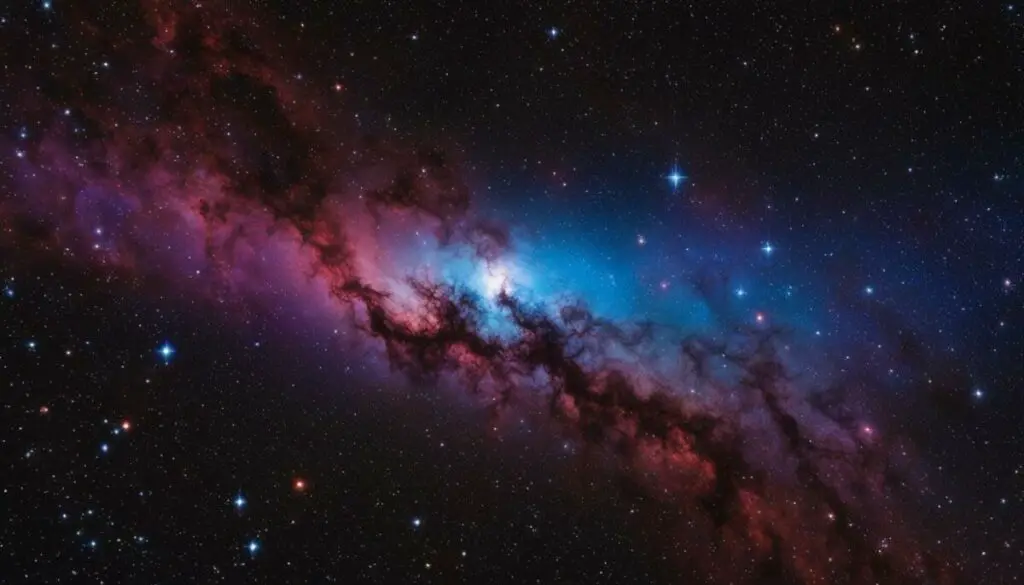
When it comes to exploring the vast mysteries of the universe, infrared astronomy has become an invaluable tool. By observing infrared light, scientists are able to uncover hidden features and unlock the secrets of celestial objects that are not visible in other wavelengths. This branch of astronomy allows us to peer into the hidden corners of the universe and gain a deeper understanding of its composition and evolution.
The key advantage of using infrared light in astronomy is its ability to penetrate dust more easily than visible light. This means that scientists can observe objects that emit infrared light, such as newly forming stars, even when they are obscured by dense interstellar clouds. By capturing the infrared emissions, astronomers can study star formation processes, investigate the early universe, and gain insights into the evolution of galaxies over time.
“Infrared astronomy has revealed a hidden universe that would otherwise remain invisible to us. It has allowed us to study objects and phenomena that were previously shrouded in darkness.”
– Dr. Emily Smith, Astrophysicist
Another important aspect of infrared astronomy is the phenomenon of redshifting. As the universe expands, the light coming from distant galaxies is stretched, shifting toward the red end of the spectrum. By studying this redshifted light, scientists can gather valuable information about the age and distance of these distant galaxies, as well as gain insights into the nature of dark matter and the evolution of the universe itself.
Overall, infrared astronomy plays a critical role in expanding our knowledge of the universe and revealing its hidden wonders. From unraveling the mysteries of star formation to studying the early universe, the use of infrared light enables scientists to explore the cosmos in ways that were previously unimaginable. As technology continues to advance, we can expect further discoveries and breakthroughs in this fascinating field of astronomy.
The Power of Infrared Astronomy
Infrared astronomy has revolutionized our understanding of the universe by:
- Revealing hidden celestial objects and features that are invisible in other wavelengths.
- Providing insights into star formation processes and the early universe.
- Allowing the study of distant galaxies through redshifted light.
By harnessing the power of infrared light, astronomers can peer into the hidden universe and uncover its most profound secrets.
Infrared Astronomy: Opening New Frontiers
| Discoveries Made Possible by Infrared Astronomy | Significance |
|---|---|
| Observation of newly forming stars obscured by interstellar dust clouds | Advances our understanding of star formation and the processes that shape galaxies |
| Study of distant galaxies through redshifted light | Provides insights into the early universe, dark matter, and the evolution of galaxies over time |
| Identification of previously hidden celestial objects and phenomena | Expands our knowledge of the cosmos and reveals the unseen wonders of the universe |
Infrared astronomy continues to push the boundaries of our knowledge, opening new frontiers in the exploration of the universe.
Exploring the Dynamic Galactic Center
The galactic center is a fascinating and dynamic region of our Milky Way galaxy that is teeming with activity. Turbulent gas clouds, star formation theories, and ionized hydrogen emissions are just a few of the captivating features that astronomers are studying in this extreme environment. Infrared observations from the James Webb Space Telescope have provided us with a wealth of data, unveiling intricate details and structures that challenge our current understanding of star formation.
One of the most intriguing aspects of the galactic center is the presence of turbulent gas clouds. These massive clouds of gas and dust collide and interact, creating a chaotic environment that fuels the formation of new stars. The James Webb Space Telescope’s infrared capabilities allow us to peer through the veil of dust and observe the intricate processes at play. By studying the dynamics of these gas clouds, astronomers can gain insights into the mechanisms behind star formation and the evolution of galaxies.
In addition to turbulent gas clouds, astronomers are also fascinated by the star formation theories that are at work in the galactic center. The intense environment of this region provides a unique opportunity to study the formation of massive stars, which are much rarer in other parts of the galaxy. By observing the formation and evolution of these massive stars, scientists hope to refine their understanding of the processes that shape galaxies and the universe as a whole.
| Galactic Center Features | Observations from James Webb Space Telescope |
|---|---|
| Turbulent gas clouds | Infrared observations reveal intricate structures and dynamics |
| Star formation theories | Study of massive star formation challenges current theories |
| Ionized hydrogen emissions | Provides valuable data on the energized gas and its properties |
Ionized hydrogen emissions also play a significant role in the galactic center. These emissions are produced by the interaction of energetic particles with hydrogen gas, revealing the presence of intense radiation and outflowing winds from massive stars. The James Webb Space Telescope’s infrared observations allow us to study these ionized hydrogen emissions in detail, providing valuable insights into the properties of the energized gas and its role in the galactic ecosystem. The needle-like structures within the ionized hydrogen emissions are of particular interest, as they offer clues about the complex processes occurring in this extreme environment.
As astronomers continue to explore the dynamic galactic center, the James Webb Space Telescope’s infrared observations will undoubtedly lead to further breakthroughs and a deeper understanding of the mysteries that lie within. The intricate details and structures observed challenge our current star formation theories and shed light on the evolution of galaxies. By unraveling the complexities of the galactic center, we gain valuable insights into the formation and evolution of stars, galaxies, and the universe itself.
The Future of Infrared Technology
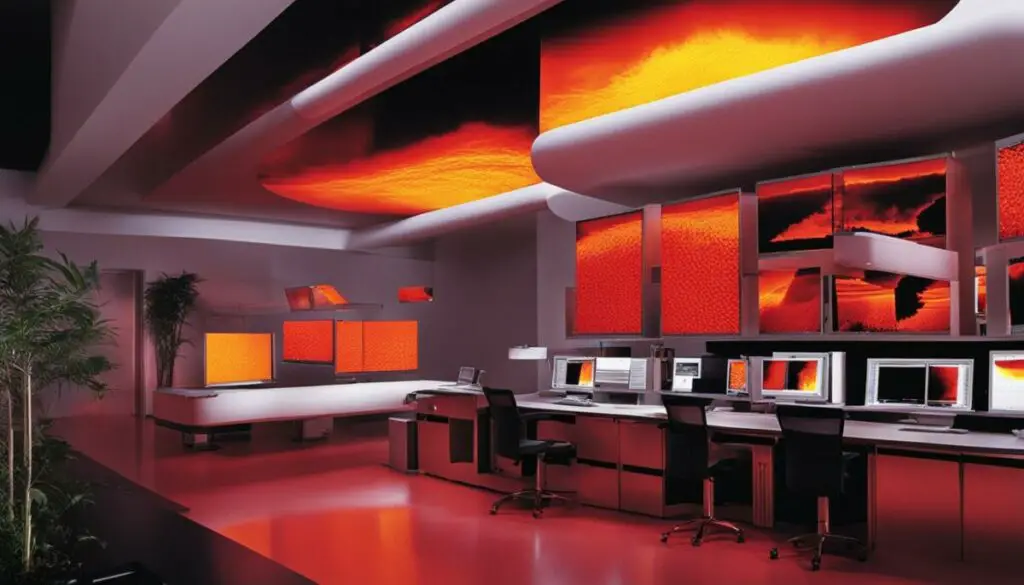
Advancements in infrared technology have paved the way for innovative applications across various industries. As we continue to push the boundaries of technological capabilities, the future of infrared holds immense promise and potential.
One area that is expected to benefit greatly from these advancements is autonomous vehicles. Infrared sensors can enhance the safety and functionality of self-driving cars by providing accurate detection of obstacles, pedestrians, and other vehicles, especially in challenging weather conditions or low-light environments.
Surveillance systems are another field where infrared technology is making significant strides. Infrared cameras can capture thermal signatures, allowing for improved monitoring and detection of intruders or potential threats. This technology has the potential to revolutionize security systems and provide enhanced situational awareness.
Medical imaging is yet another area that stands to benefit from the future of infrared technology. Infrared imaging techniques can provide valuable insights into the human body, allowing for the early detection of diseases and abnormalities. This non-invasive approach could potentially revolutionize medical diagnostics and improve patient outcomes.
In conclusion, the future of infrared technology is bright and full of possibilities. From autonomous vehicles to surveillance systems and medical imaging, advancements in this field are poised to revolutionize various industries and improve our lives in countless ways.
The Impact of Infrared on Our Lives
Although often unnoticed, infrared technology has a significant impact on our daily lives. It is widely used in various applications, enhancing our safety, comfort, and efficiency. Let’s explore some of the everyday applications of infrared technology and how it improves the performance of numerous devices and systems.
Night Vision
Infrared technology plays a crucial role in night vision devices, allowing us to see in complete darkness. Military personnel, law enforcement agencies, and hunters rely on night vision goggles and cameras to navigate and perform tasks effectively in low-light conditions. By capturing infrared radiation emitted by objects and converting it into a visible image, these devices provide enhanced situational awareness and improve safety.
Medical Diagnostics
Infrared technology has revolutionized medical diagnostics, enabling non-invasive and accurate assessments of various conditions. Infrared thermography, for example, is used to detect abnormalities in blood flow and temperature distribution, aiding in the diagnosis of conditions such as breast cancer and peripheral vascular diseases. Infrared imaging is also used in ophthalmology to detect early signs of diseases like diabetic retinopathy. These applications highlight the invaluable role of infrared technology in improving healthcare outcomes.
Industrial Inspections
Infrared technology is extensively employed in industrial inspections, ensuring the safety and efficiency of manufacturing processes and equipment. By detecting temperature anomalies, infrared cameras help identify potential issues in electrical systems, mechanical components, and insulation, preventing costly failures and accidents. Furthermore, infrared thermal imaging is used to monitor the condition of boilers, pipelines, and other critical infrastructure, enabling proactive maintenance and reducing downtime.
| Everyday Applications of Infrared Technology | Benefits |
|---|---|
| Night Vision | Enhanced situational awareness and safety in low-light conditions |
| Medical Diagnostics | Non-invasive assessment, early detection of diseases |
| Industrial Inspections | Preventive maintenance, increased safety and efficiency |
As we can see, infrared technology has become an integral part of our everyday lives. From enhancing our vision in the dark to improving medical diagnostics and ensuring the integrity of industrial processes, the applications of infrared technology are vast and diverse. By harnessing the power of infrared, we continue to unlock new possibilities and improve various aspects of our daily experiences.
Embracing the Invisible World of Infrared
While the human eye is limited to perceiving the visible light spectrum, the development of infrared technology has allowed us to explore and harness the power of the invisible world of infrared radiation. Infrared rays, though invisible to us, hold valuable information and applications in various industries and scientific fields. They have become an essential tool in night vision, medical diagnostics, electrical maintenance, and even space exploration.
One of the significant limitations of the human eye is its inability to perceive infrared radiation. While we can see the colors of the rainbow, including red, orange, yellow, green, blue, indigo, and violet, we are unable to see the wavelengths of light that fall outside this range. However, other organisms, such as snakes, possess specialized sensory organs that allow them to detect and perceive infrared radiation as heat. This unique ability has aided their survival and hunting strategies, giving them an advantage in certain environments.
Infrared technology has opened up a new world of possibilities, enabling us to study and understand phenomena that were once hidden from our perception. By detecting and capturing infrared radiation using specialized sensors and cameras, we can visualize temperature variations, identify electrical issues, and explore celestial objects in ways that were not previously possible. From identifying defects in electrical systems to observing distant galaxies and studying star formation, infrared technology continues to expand our knowledge and push the boundaries of human understanding.
In conclusion, the development and utilization of infrared technology have allowed us to overcome the limitations of the human eye and explore the invisible world of infrared radiation. This expansion of perception has revealed invaluable insights and practical applications in various fields. As technology advances further, we can expect even more innovative uses of infrared technology, enhancing our understanding of the natural world and improving our lives in countless ways.
Conclusion
In conclusion, although infrared rays are invisible to the human eye, their impact and significance cannot be understated. The development and utilization of infrared technology have revolutionized various industries and scientific fields. From night vision to medical diagnostics, infrared technology has enhanced our safety, efficiency, and understanding of the world around us.
The James Webb Space Telescope has played a pivotal role in unveiling the hidden mysteries of the universe through the detection of infrared light. Its observations have provided invaluable data on star formation, the early universe, and the evolution of galaxies, challenging existing theories and expanding our knowledge of the cosmos.
Looking ahead, the future of infrared technology holds great promise. With ongoing advancements and innovative applications, we can expect to see its integration into even more industries and everyday life. From autonomous vehicles to medical imaging, the possibilities for infrared technology are vast and exciting.
FAQ
Are infrared rays visible to the human eye?
No, infrared rays are not visible to the human eye. They fall outside the range of the visible light spectrum.
What is infrared technology?
Infrared technology is a system that uses specialized instruments and sensors to detect and measure infrared radiation emitted by objects with a temperature above absolute zero.
What are some applications of infrared technology?
Infrared technology is used in various industries and everyday life. It is used in night vision, remote controls, medical diagnostics, home insulation assessments, and industrial inspections, among other applications.
How is infrared technology used in electrical maintenance?
Infrared thermographic inspections are used to identify temperature anomalies in electrical components, which can indicate potential issues such as loose connections or overloading.
What is the role of infrared in astronomy?
Infrared light plays a crucial role in astronomy by revealing hidden features and mysteries in celestial objects. It allows astronomers to study star formation, investigate the early universe, and observe objects that emit low-energy infrared light.
What has the James Webb Space Telescope revealed about the Milky Way’s center?
The James Webb Space Telescope has provided valuable data on star formation in the active region known as Sagittarius C in the center of the Milky Way galaxy. It has helped scientists understand the formation of stars in this extreme environment and the prevalence of massive stars.
Infrared observations allow scientists to study objects that emit infrared light, which can penetrate dust more easily than visible light. Infrared observations also reveal redshifted light from distant galaxies, providing insights into the early universe, dark matter, and galaxy evolution.
What does infrared detection of the galactic center reveal?
Infrared observations from the James Webb Space Telescope have provided intricate details and structures in the galactic center that challenge current theories of star formation. Scientists are particularly interested in the energized gas and needle-like structures within the ionized hydrogen emissions.
What can we expect from the future of infrared technology?
Advancements in infrared technology will continue to drive innovation in areas such as autonomous vehicles, surveillance systems, and medical imaging.
How does infrared technology impact our daily lives?
Infrared technology is widely used in various applications such as night vision, remote controls, medical diagnostics, home insulation assessments, and industrial inspections, enhancing our safety, comfort, and efficiency.
Can humans perceive infrared rays?
No, humans cannot perceive infrared rays as heat. Our perception is limited to the visible light spectrum.
What is the significance of the invisible world of infrared?
The development of infrared technology has allowed us to explore and utilize the invisible world of infrared radiation, expanding our understanding of the natural world and unlocking new possibilities.








